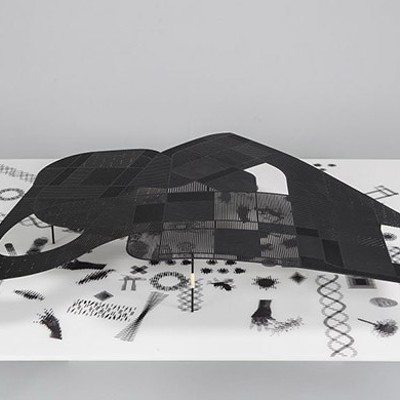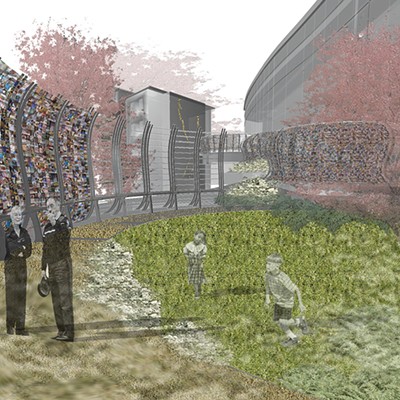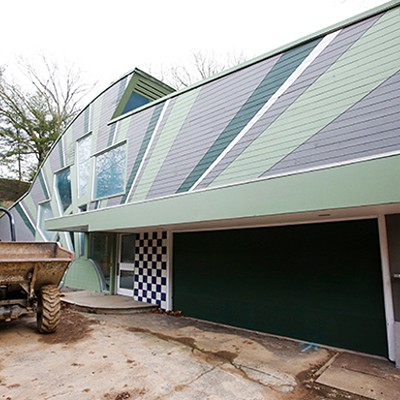In the new Posner Center at Carnegie Mellon University, three remarkable and rare scientific editions share one display case. A 16th-century printing of Ptolemy's second-century work Magnae Constructionis, a first edition of Nicolaus Copernicus' De Revolutionibus Orbium Coelestium of 1543 and a first edition of Albert Einstein's Die Gründlage der Allgemeinen Relativití¤tstheorie of 1916 are highlights of the Posner Collection of Rare and Fine Books, which, having been housed for years in the Hunt Library, now occupies the new building and shares it with a high-tech meeting room for the board of directors. Part of a cohesive thematic display, these three volumes really describe diametrically diverging views of our place in the universe: Ptolemy's earth-centered view of the solar system, Copernicus' sun-centered view, and Einstein's center-less view.
If only drastically differing opinions could coexist so quietly during faculty meetings.
Actually, when it comes to this building, they do, at least in the architecture department, where I am an adjunct faculty member. But there has been little public commentary about the structure's design, created by WTW Architects. The one-story, ground-level building between the College of Fine Arts and the not-coincidentally named Posner Hall of the Tepper School of Business, is low in height, but still visually very prominent. Nonetheless, many people within CMU handle discussions about the building's design with the delicacy they would accord one of the rare books inside.
Quite appropriately, many have focused on the Posners' generosity. The family has given major philanthropic support to Carnegie Mellon and other institutions over a number of decades. In this case, administration officials describe the new structure's meeting facility as a crucial need, and the higher visibility for the rare books is entirely appropriate. The tomes are, after all, a prized and singular asset that should be the envy of any university.
The architecture, then, should reflect the considerable erudition and discriminating taste that the collection embodies. It should open the door on the complex intellectual enterprise of collecting in more than a simply literal way. After all, rare books in first or early editions suggest a stately and measured progress of ideas and civilization. Even if we know Ptolemy was just plain wrong, we value his longstanding influence and importance in the history of ideas. Copernicus and Einstein seem all the more remarkable in light of their predecessor. On the other hand, Einstein notes that time itself is relative and changing, and theoretically offers the possibility of reversing the sequence we would like to attribute to it.
This might seem like an unnecessarily overwrought premise for architecture. But Henry Hornbostel's adjoining College of Fine Arts is itself rumination on tradition and modernity, the past and the future, and the obligation of architecture to bind our heritage and our legacy convincingly together as one. He drew intelligently from history while using materials and details that were as up-to-date as possible.
This new building engages in no such intellectual debate. It is lavish and well-constructed, but the cascading trays of granite that make up the façade are wildly inappropriate, the profusion of rounded corners seemingly meaningless. Not only do they seem like an odd '60s leftover, but they are completely and unnecessarily at odds with Hornbostel's brilliant building on one side and a good building by Kallmann McKinnell and Wood on the other -- although there was a fairly irrelevant attempt to match the new granite with Hornbostel's concrete.
Inside, the building is neither fish nor fowl. The displayed books are great to see, so why not show more of them? Space for archival research is paltry, but catering facilities for board meetings are generous. There is an identity crisis here, as one might expect in a hippie-era design with a staid neoclassical inscription across the front.
Another legitimate criticism is that this building apparently learns nothing from the knowledge of energy efficiency developed in the Department of Architecture's Intelligent Workplace or its proposed Building as Power Plant project.
Probably the last thing the CMU campus needs is another watered-down yellow brick building, but there are plenty of modern architects who can express contemporaneity without effacing tradition. Let's hope that as time progresses, we can view this design as we do Ptolemy: appreciating its value even though it does not reflect our current understanding of the architectural universe.


















